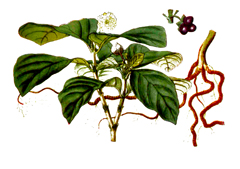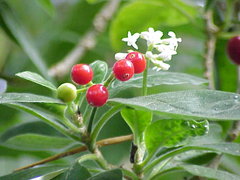 |
|
https://edibleplants.org/ |
 |
| www.biolib.de |
Translate this page:
Summary
Ipecac, Carapichea ipecacuanha, is a small flowering shrub that only grows up about 50 cm tall. It is native to Costa Rica, Nicaragua, Panama, Colombia, and Brazil. Mainly a medicinal plant, its roots are used against many ailments such as coughs, fever, amoebic dysentery, and bronchitis. It is used to make a powerful emetic known as “syrup of ipecac”. However, when consumed in high amounts, severe vomiting and diarrhoea will be experienced.
Physical Characteristics

 Carapichea ipecacuanha is an evergreen Shrub growing to 0.5 m (1ft 8in) by 0.5 m (1ft 8in) at a medium rate.
Carapichea ipecacuanha is an evergreen Shrub growing to 0.5 m (1ft 8in) by 0.5 m (1ft 8in) at a medium rate.
See above for USDA hardiness. It is hardy to UK zone 10.
Suitable for: light (sandy), medium (loamy) and heavy (clay) soils and prefers well-drained soil. Suitable pH: mildly acid, neutral and basic (mildly alkaline) soils and can grow in very acid soils.
It can grow in full shade (deep woodland) or semi-shade (light woodland). It prefers moist soil.
UK Hardiness Map
US Hardiness Map
Synonyms
Callicocca ipecacuanha Brot. Cephaelis acuminata H.Karst. Cephaelis ipecacuanha (Brot.) A.Rich. Evea
Plant Habitats
Edible Uses
References More on Edible Uses
Medicinal Uses
Plants For A Future can not take any responsibility for any adverse effects from the use of plants. Always seek advice from a professional before using a plant medicinally.
Antitussive Dysentery Emetic Expectorant Febrifuge Homeopathy
The roots of ipecac contain a number of medically active constituents including isoquinoline alkaloids, tannins and glycosides[ 254 ]. They have a violently irritant action, stimulating the gastric and bronchial systems, lowering fevers and preventing cyst formation in amoebic dysentery[ 238 ]. The roots are used internally in the treatment of coughs, bronchitis, whooping cough and amoebic dysentery[ 238 , 254 ]. One of the surest of emetics, even moderate doses will induce vomiting until the contents of the stomach have been voided making it especially useful in the treatment of drug overdoses[ 254 ]. It is used in a syrup to induce vomiting in children who have ingested toxins[ 238 ]. Smaller doses are strongly expectorant and it is a common ingredient in patent cough medicines[ 254 ]. The plant needs to be used with caution since excess causes severe vomiting and diarrhoea[ 238 ]. The roots are harvested, usually when about 3 years old and the plants are in flower, and are dried for later use[ 238 , 254 ]. The plants are replanted after partial removal of the roots[ 238 ]. The plant is used in homeopathy in the treatment of nausea[ 238 ].
References More on Medicinal Uses
The Bookshop: Edible Plant Books
Our Latest books on Perennial Plants For Food Forests and Permaculture Gardens in paperback or digital formats.

Edible Tropical Plants
Food Forest Plants for Hotter Conditions: 250+ Plants For Tropical Food Forests & Permaculture Gardens.
More

Edible Temperate Plants
Plants for Your Food Forest: 500 Plants for Temperate Food Forests & Permaculture Gardens.
More

More Books
PFAF have eight books available in paperback and digital formats. Browse the shop for more information.
Shop Now
Other Uses
Other Uses: None known
Special Uses
References More on Other Uses
Cultivation details
Prefers a minimum temperature in the range of 15 - 18°c[ 238 ]. Prefers a well-drained humus-rich soil and a shady position[ 238 ]. Plants need ample moisture and humidity if they are to thrive[ 238 ].
References Carbon Farming Information and Carbon Sequestration Information
Temperature Converter
Type a value in the Celsius field to convert the value to Fahrenheit:
Fahrenheit:
The PFAF Bookshop
Plants For A Future have a number of books available in paperback and digital form. Book titles include Edible Plants, Edible Perennials, Edible Trees,Edible Shrubs, Woodland Gardening, and Temperate Food Forest Plants. Our new book is Food Forest Plants For Hotter Conditions (Tropical and Sub-Tropical).
Shop Now
Plant Propagation
Seed - Greenwood cuttings in a sandy compost[ 238 ]. Root cuttings.
Other Names
If available other names are mentioned here
Ipecac, Carapichea ipecacuanha.
Native Plant Search
Search over 900 plants ideal for food forests and permaculture gardens. Filter to search native plants to your area. The plants selected are the plants in our book 'Plants For Your Food Forest: 500 Plants for Temperate Food Forests and Permaculture Gardens, as well as plants chosen for our forthcoming related books for Tropical/Hot Wet Climates and Mediterranean/Hot Dry Climates. Native Plant Search
Found In
Countries where the plant has been found are listed here if the information is available
Coming Soon
Weed Potential
Right plant wrong place. We are currently updating this section.
Please note that a plant may be invasive in one area but may not in your area so it’s worth checking.
None Known
Conservation Status
IUCN Red List of Threatened Plants Status : This taxon has not yet been assessed

Growth: S = slow M = medium F = fast. Soil: L = light (sandy) M = medium H = heavy (clay). pH: A = acid N = neutral B = basic (alkaline). Shade: F = full shade S = semi-shade N = no shade. Moisture: D = dry M = Moist We = wet Wa = water.

Expert comment
Author
(Brot.) L.Andersson
Botanical References
Links / References
For a list of references used on this page please go here
A special thanks to Ken Fern for some of the information used on this page.
Readers comment
| Add a comment |
|
If you have important information about this plant that may help other users please add a comment or link below. Only comments or links that are felt to be directly relevant to a plant will be included. If you think a comment/link or information contained on this page is inaccurate or misleading we would welcome your feedback at [email protected]. If you have questions about a plant please use the Forum on this website as we do not have the resources to answer questions ourselves.
* Please note: the comments by website users are not necessarily those held by PFAF and may give misleading or inaccurate information.
To leave a comment please Register or login here All comments need to be approved so will not appear immediately.
|
Subject : Carapichea ipecacuanha
|
|
|
|